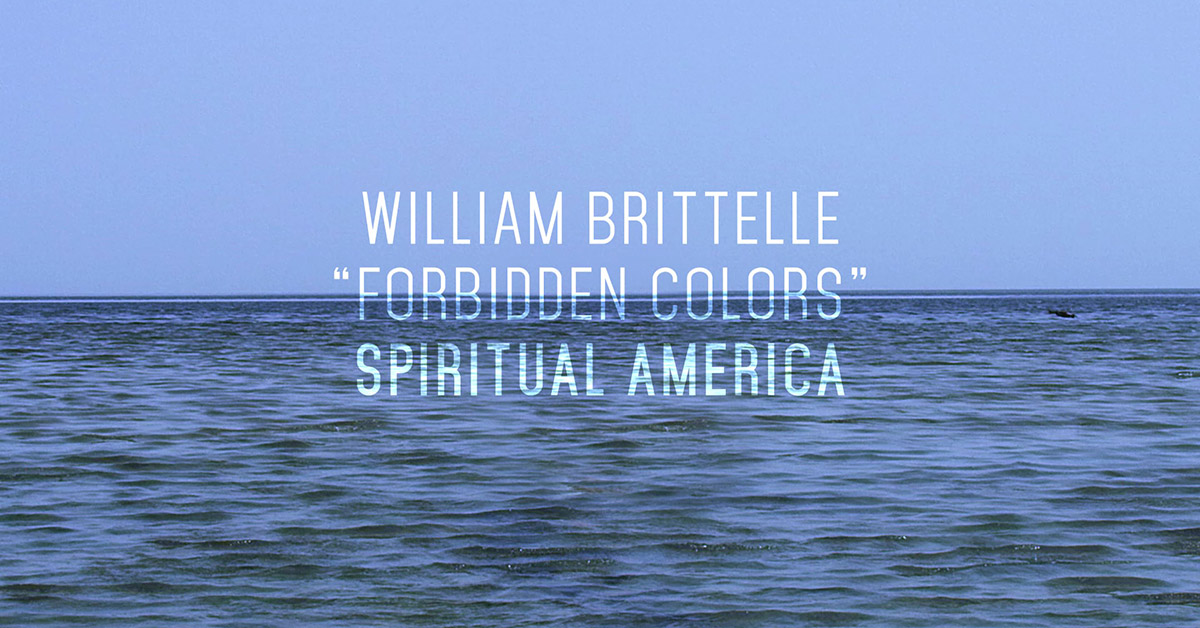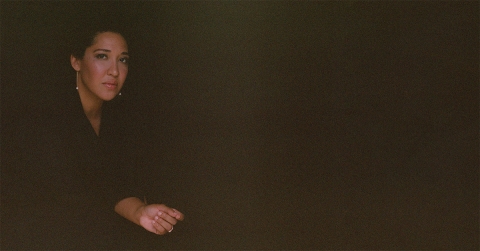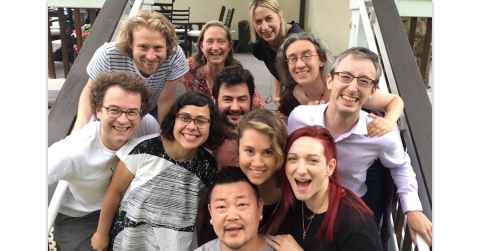Composer William Brittelle has shared the full score for and story of "Forbidden Colors," from his new album, Spiritual America. On the album, Wye Oak, Brooklyn Youth Chorus, and the Metropolis Ensemble perform a genre-defying electro-acoustic song cycle written by Brittelle, who works to reconcile his youth in a conservative Christian household with his adult life as an "agnostic Buddhist." You can download the "Forbidden Colors" score and follow along as Brittelle breaks it down here.
Composer William Brittelle has shared the full score for and story behind "Forbidden Colors," the fifth track from his new album, Spiritual America, out now on Nonesuch/New Amsterdam Records. On the album, Wye Oak, Brooklyn Youth Chorus, and the Metropolis Ensemble perform a genre-defying electro-acoustic song cycle written by Brittelle, who works to reconcile his youth in a conservative Christian household with his adult life as an "agnostic Buddhist." Brittelle co-produced the album with Zach Hanson, who mixed it as well. You can download the "Forbidden Colors" score here and follow along as Brittelle breaks it down below.
M 1–18 OPENING (0:00-0:37)
The first record I ever owned was a single of Whitesnake's "Is This Love." The experience of listening to the intro of that song on my own turntable for the first time has haunted me ever since. It felt like the descent into another world—like gradually being covered by a warm blanket of mystery and freedom. The opening of "Forbidden Colors" basically apes Whitesnake's intro as a way of transitioning into a world of nostalgia, a world where innocence, faith, and doubt all co-exist. Following the opening chord, Zach [Hanson] and I bathed the strings and saxes in heavy delay to accentuate the dreamlike texture. The lyrics reference watching the Playboy channel scrambled as a child, hearing only the sounds of procreation against the visuals of black and grey static waves. The stadium/pentagram line is a direct reference to Mötley Crüe's video for "Home Sweet Home," which I watched countless times while writing this track. Growing up a child of the church, no symbol carried more forbidden intrigue to me than the pentagram, especially when evoked by men who were transgressively beautiful and alluring in their make-up and long hair.
M 18–26 SOLO 1 (0:38–0:55)
This section snaps us back to now: the distorted synth is inspired directly by "On Sight," the opening track from Kanye West's Yeezus. I needed a sound that essentially acted as a rude foil to the world of nostalgia, a harsh wake-up call into a more complicated and immediate reality. There are self-made iPhone recordings throughout this track, and the first appears here, chopped up and set deeply in the mix. The word, repeated and pitched up, is "reckoning." The guitar solo is fully scored but sculpted to sound soloistic. I've spent way too much time in my life playing midi guitar solos on shitty keyboards and then notating them. As with the Yeezus synth, we used bit crush distortion to create an early-digital feel. Measure 23 in the trumpet is an example of the echo effect we used throughout the record—we often gradually pan these gestures from center to hard left or right to give the sense of moving through space.
M 27–43 CHORUS 1 (0:55–1:29)
The first glimpse of this track that emerged from my subconscious was the chord progression and vocal line that enters at measure 27. Not to be too heavy-handed, but these lines are essentially the key to unlocking the track. I wanted a pure pop melodic moment that merged the world of my youth and the world of my "now" together in a memorable, convincing way. In this section we have the synth from the opening paired directly with the distorted Yeezus synth, Jenn [Wassner, of Wye Oak]'s voice is paired with the youth of the chorus. These lines are meant to directly connect thematically with the ending, and to underscore all of the "action" moving forward. The sample "you're a part of me" is from an iPhone diary entry I recorded to myself, not intending to share. It references the inescapability of nostalgia (at least in my experience)—how we often feel powerless against its allure, especially in times of great turmoil.
M 43–51 INTERLUDE (1:29–1:46)
In this section, "nostalgia" starts to break down and splinter, but with a very '80s fretless bass and muted guitar dual solo to anchor it. A sampled and morphed version of the chorus singing "nostalgia" is sprinkled throughout. In measure 50–51 the tremolo strings transition us into starkly new terrain.
M 52–64 HERCULEAN 1 (1:46–2:11)
With the dawning of this next section, we are fully in the world of the past. The line “waves of light” is essentially a reference to the power of physically intimacy. Specifically adolescent, delightfully-forbidden-but-also-somehow-innocent making out. The kind of experience that staples itself onto your brain without you realizing it and forms an insurmountable high point of simplicity and desire that your complicated adult self helplessly craves for all eternity. The "light" in this sense, is the purity of that desire, the "all-ness" of it, and the correspondingly intoxicating and freeing loss of self. The Brooklyn Youth Chorus echoes and frames this experience like a Greek chorus against the backdrop of delayed brass and saxes, and, in measure 62, the non-vibrato strings descend back into ...
M 65–80 SOLO 2 (2:12–2:42)
... the terror and confusion of the present day. This section features an extended and fully notated distorted guitar solo with pointillistic orchestral interjections. The harmonic material is extended and generally pretty dissonant. Compositionally, I was trying to avoid evoking "rock" or "jazz" and instead create a zone that spoke directly to the hidden turmoil and struggle of a splintered adulthood in a visceral way. I love the color and feel of electric guitar so much but hate how most people immediately hear "rock" whenever one enters and start thinking all genre-y. It's really a fascinating color and sound when you remove all the meta coding, which is what I was trying to do here. The cascading winds, walls of brassy brass, and percussion fills are often outside the harmony of the guitar, increasing the tension of the section, culminating in a wall of sound approach at measure 80.
M 81–91 BRIDGE (2:42–3:03)
I'm really attracted to "rate of change" as a formal approach. Meaning, instead of using the return of familiar material to dictate form, I try to introduce truly unexpected material as a way to mark time. I find that this technique (often referred to as frisson) creates structure while encouraging active, engaged listening and increasing drama (essentially my core aim at all times). I've never been a big fan of minimalism or trance music; I think my attention span is too short for it. I'm much more attracted to moments like these. In this section, I knew I wanted to get back to "waves of light," so I wiped the slate clean with pizzicato strings and staccato brass, essentially new colors to this track, in a distant key, giving myself about ten seconds to find my way back to ...
M 91–100 HERCULEAN REDUX/OPENING REDUX (2:42–3:41)
... "waves and waves of light," now paired with the overdriven guitar and fretless base in sync with the chorus and lead vocal. An almost monolithic representation of nostalgia's true depth and power. My aim was to evoke how immovable, how entrenched these moments become in our life, casting a shadow over everything that follows when viewed from our darker adult moments. While writing this record, I was really struggling with being a father, husband, friend, artist—I felt inadequate in every regard, like I had oversold myself to those I loved most deeply. Although this album began as an exploration of spirituality, it ended up really centering around my relationship with the past and the present. While making the record, I often found myself driving around listening to hair metal lost in a nostalgic haze. But, in a sense, making this record was my path back to the present moment. It was my way of merging two selves into a new, fully functional worldview in which Def Leppard, Jesus, Buddah, Oneohtrix Point Never, Zima, and kombucha can all co-exist.
But, I digress ... in measure 99, our moment of purity begins to melt back into a return of the intro. Here, the "Whitesnake" synth sneaks in under the now dimming light, along with delayed winds and string glisses. The lyrics here reference a Mötley Crüe album directly (the one with the pentagrams), and give a sense of place and context to the actions associated with "waves of light." The section ends with a final plainly stated "I remember waves of light," and that final "light" gets twisted and swelled into the following section.
M 100–117 CHAOS THEME (3:42–3:52)
We're back in the land of Yeezus, the land of the present, the land of existential crisis and unsolvable adult problems. A land without a Messianic figure or any kind of protective dome. The terror and panic swells until it finally breaks.
M 118–END CODA (3:53–END)
I rarely drink when I compose, but this section is one of two notable exceptions on this record (see also: "Strange Asylum"). Much of this track wasn't written chronologically, but measures 100 to the end were. After finishing the previous section, I was totally stuck. I knew I couldn't end the track in chaos, but I got caught in a loop of overthinking. Most of this record was written in my childhood bedroom; I just couldn't access the world of Spiritual America anywhere else. So, sitting in my old room, I decided to have a couple beers and pummel myself to death with nostalgia. I looked through old yearbooks, watched '80s videos (mainly this one), read letters from old girlfriends, looked at old prom pictures ... until I broke. Just started crying and singing the line "as if I could forget it all" over and over against a simple fretless bass pattern. Essentially, the coda emerged fully formed from a state of non-judgement/emotional drunkenness. The rest of the track took forever to compose, but the ending only needed a couple hours and a few Manhattans. I still have a hard time listening to the coda casually. For me it was such a deeply cathartic moment, such a necessary moment. And it was tricky to mix; we ended up putting a huge amount of reverb on Andy's percussion and messing around a bunch with Jenn's vocals. We also re-sampled the fretless part and added some pitch bends and graininess—it was sounding too "good" out of the box. As a final touch, we decided to loop the ending into a fade-out during mixing to give the track a sense of infinitude and to lead properly into the next track, "Birds of Paradise."
- Log in to post comments



